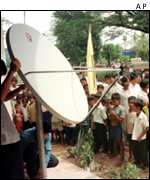Alex Kirby . BBC News . 24 december 2001
 The Sun impressed the ancients: It is one energy source we have just begun to exploit |
 There is huge potential for renewable energy |
 Solar power can spread information |
The United Nations Environment Programme (Unep) is trying to identify the best sites for wind and solar energy in 13 developing countries.
It believes the scheme will prove renewable energy sources have far more potential than supposed. Unep hopes its findings will encourage investors to finance green energy schemes.
It says the project will help both to tackle climate change and to relieve poverty.
The countries where the surveys are to be carried out are Bangladesh, Brazil, China, Cuba, El Salvador, Ethiopia, Ghana, Guatemala, Honduras, Kenya, Nepal, Nicaragua and Sri Lanka.
Closing the gap
The project is called the Solar and Wind Energy
Survey Assessment (Swera). It will enable prospective developers to pinpoint
promising locations online.
Dr Klaus Toepfer, Unep's executive director, said one obstacle to the widespread introduction of solar and wind power, despite the recent rapid fall in their costs, was uncertainty over how much could be available.
He said: "The Swera project aims to bridge this knowledge gap so potential investors can know, with a great deal of accuracy, the locations where they can secure a good and reasonable return.
"If we can accelerate the deployment of renewable energy we can not only bring down the costs, but also help in the fight against global warming and poverty.
"In many developing countries the scarcity of energy is driving more and more people into poverty.
"Those without access to electricity are forced to fell trees for firewood and cooking fuel, accelerating impacts such as soil erosion and the loss of the world's wildlife."
Tom Hamlin, climate change task manager in the Unep/Global Environment Facility's co-ordination unit based in Nairobi, Kenya, gave an example of what the project might achieve.
He said: "The efficiency of steam turbines operated with concentrated solar thermal energy is strongly affected by fluctuating solar energy input.
"Such dynamic effects, which may easily reduce performance by 10-20%, can only be specified if the solar radiation intensity is known on an hour-by-hour basis.
"Those insecurities have presented a considerable obstacle to the widespread use of solar thermal power technology up to now. Swera will, we believe, considerably reduce those uncertainties."
Exceeding expectations
Unep believes the mapping will show the
wind and solar resources of the 13 countries are much bigger than thought.
It is encouraged by recent work in the Philippines.
A pre-feasibility study for a 40 Megawatt (MW) wind farm, the first important one in the country, was carried out by the Philippine National Oil Corporation within six months of the completion recently of a survey and national atlas of wind potential.
Before the survey the official projection for wind power in the Philippines in the coming decade was around 100 MW.
Unep says the findings from the survey could lead to 480 MW in place by 2008, and as much as 2,000 MW by 2015.
Dr Jeremy Leggett of Solar Century, a UK company, told BBC News Online: "Solar power offers a huge double prize.
"There are two billion people who need this technology, and it's already competing with the alternatives they have to use, like kerosene. Even in the industrialised world, in a cloudy country like the UK, we can supply all our electricity needs from solar panels on buildings.
"The UK Government's recent leaked energy review, and private correspondence we've had with the government, are encouraging. The mood music is good. The government knows this is an enabling technology that could be the centrepiece of a knowledge-based economy."